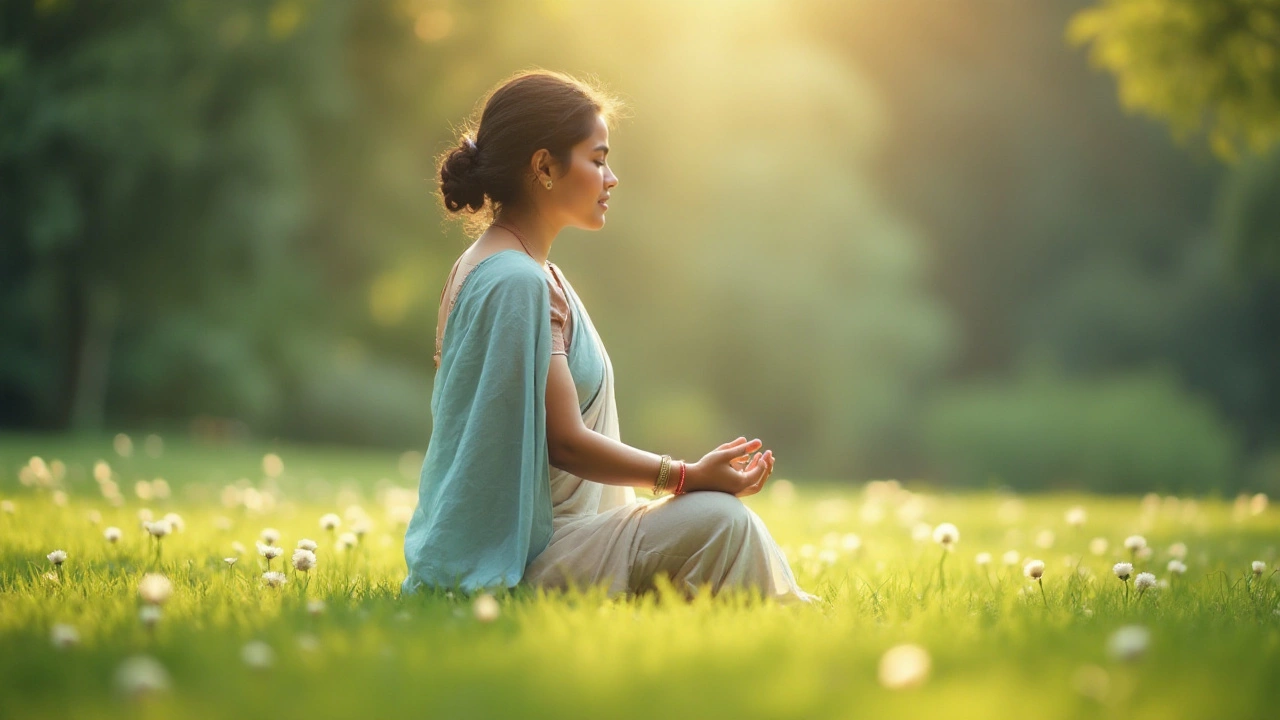In the heat of summer, the right color choice can mean the difference between a refreshing experience and an uncomfortable one. Have you ever wondered why some colors just seem to scream 'summer'? There's more to it than aesthetic appeal. Colors can cool you down and uplift your mood, a perfect blend of form and function for warm-weather fashion.
As much as style gurus urge us to embrace the entirety of the color spectrum, summer offers a unique chance to experiment with hues that not only elevate style but also enhance comfort. From aquatic blues to pastel shades, these colors don't just look cool—they actually help keep you cool.
- The Science of Color and Temperature
- Psychological Effects of Colors
- Top Cool Colors for Summer
- Color Combination Tips
- Building a Cool Summer Wardrobe
The Science of Color and Temperature
When it comes to staying cool in the sweltering heat of summer, the colors you choose to wear play a surprisingly significant role. The fundamental science behind this revolves around the way different colors interact with light and heat. It's not just about looking stylish—it's about how those coolest color choices can keep your body temperature in check.
How Colors Absorb and Reflect Light
At the heart of this interaction is the spectrum of light. Light colors, particularly whites and pastels, tend to reflect more sunlight rather than absorbing it. This reflection process is where these colors earn their reputation as the coolest for summer fashion. Darker colors, such as blacks and navy blues, absorb more heat, making them less desirable when the temperature soars.
The Role of Material
It’s crucial to combine color choice with the right material. Fabrics like cotton and linen are breathable and tend to enhance the cooling effect of lighter colors. When you don a light-colored linen shirt, for instance, you're maximizing both color and material to beat the heat.
Scientific Studies on Color and Temperature
Research from textile experts shows that white is indeed the best color for summer clothes if you wish to stay cooler. An interesting table from a 2022 study highlights how different colors affect thermal behaviour:
| Color | Temperature Increase |
|---|---|
| White | 1-2°F |
| Light Blue | 3-4°F |
| Black | 7-8°F |
Practical Tips for Choosing Summer Colors
- Opt for light and pastel shades such as mint greens or powder blues to minimize heat absorption.
- Pair light-colored tops with slightly darker bottoms to add contrast while maintaining a cool vibe.
- Consider the time of day: as the sun sets, you can explore more vibrant hues without as much concern for temperature impact.
Understanding the interplay between color and temperature not only aids in personal comfort but elevates your style during the hottest months. This can transform standard summer clothing into a veritable oasis of coolness and fashion flair.
Psychological Effects of Colors
The colors we surround ourselves with aren't just for visual pleasure—they deeply influence our mood and behavior. This understanding can be especially important in the summer, when the right hues can help us make the most of sunny days.
Blue: The Color of Calm
Often associated with tranquility and coolness, blue is a top contender when selecting summer fashion. Studies suggest that blue can have a calming effect, reducing anxiety and lowering heart rates. Whether it’s a navy sundress or a pair of sky-blue shorts, this hue helps create a serene summer vibe.
Refreshing Greens
Drawing inspiration from nature, green can be as refreshing as a walk through a lush park. It evokes feelings of renewal and vitality. A green ensemble can invigorate the senses while providing a subliminal connection to the environment.
Cheery Yellows
Yellow, the color of sunshine, marries joy with optimism. It’s a hue that brings warmth and cheer but should be used sparingly in hot climates to avoid feeling overly warm. Consider it for accessories or subtle patterns.
Using Colors to Balance Mood
Color psychology suggests that balancing bold and subtle colors strategically in your attire can create harmony between excitement and calmness. A splash of turquoise can elevate a white summer dress, adding a dash of excitement to a relaxed look.
The Science of Temperature and Color
Did you know that color can actually affect how warm or cool you feel? Dark colors absorb more sunlight, turning it into heat, whereas lighter colors reflect more sunlight, which can help maintain cooler body temperatures in the summer swelter.
Color Influence Table
| Color | Psychological Effect | Temperature Effect |
|---|---|---|
| Blue | Calm, reducing anxiety | Cooling |
| Green | Refreshing, revitalizing | Neutral |
| Yellow | Cheerful, optimistic | Slightly warming |
Choosing the right color palette for summer clothes is thus not only about fashion. It's about enhancing your comfort while playing with the invisible strings of psychological effects. In essence, dressing in the right shades can keep your wardrobe both stylish and seasonally functional.

Top Cool Colors for Summer
When the temperatures soar, choosing the right color palette can make all the difference. The right hues not only ensure thermal comfort but also amp up one's summer fashion game. Let's dive into the shades that dominate summer wardrobes for their unique blend of aesthetics and practicality.
Aquatic Blues
Summer fashion often mimics the refreshing qualities of water with a spectrum of blues. From the serene pastel baby blues to the more vibrant Caribbean hues, these colors not only reflect calmness but also absorb less heat, keeping your body temperature cool.
Refreshing Whites
Classic, timeless, and undeniably cool, white remains a summer staple. It's not just because it pairs well with nearly anything; its high albedo effect—reflecting most of the sun's rays—helps to keep the body cooler than many other shades. Whether it's a breezy white dress or a simple tee, white is the unsung hero of a comfortable summer.
Gentle Pastels
Pastels are the silent superstars in the summer clothes lineup. Light pinks, soft lavenders, and powdery greens have low saturation, making them visually less absorbing of light and thus, cooler. They bring a subtle vibrancy to outfits without the dramatic heat impact of their brighter counterparts.
Minty Greens and Earthy Tones
Green, especially mint shades, offer a soothing vibe perfect for those long, sunny days. They remind one of nature and freshness, and similar to blues, mint shades do not retain heat. Alongside these, earthy tones like sand and beige are subtly making their mark in summer fashion, offering a sophisticated alternative to the usual bright palette.
Sun-Kissed Yellows
While yellow may seem counterintuitive for its tendency to attract attention, its lighter tints like lemon and pale yellows are excellent summer choices. They evoke happiness and joy and are less absorbing compared to darker variations.
Now that you're equipped with these insights, picking your summer wardrobe will be both a breeze and a delight. With a palette full of these coolest colors, summer promises to be stylishly refreshing.
Color Combination Tips
Creating the perfect summer outfit isn’t just about picking the right color. It's about how you combine those colors to achieve a harmonious and refreshing look. Here are some inspiring ideas to help you mix and match effectively.
Understanding the Basics
The color wheel is your best friend when it comes to selecting complementary colors. By understanding the relationships between colors, such as complementary (opposite on the wheel) and analogous (next to each other), you can create outfits that pop without clashing.
Cool Tints and Mixes
For a truly cool aesthetic, incorporate shades of blue, mint, or lavender as your dominant colors. Pair these with lighter shades like white or beige to maintain a breathable look. An outfit combining a pastel blue dress with white sneakers and a beige hat could be a perfect example.
- Monochromatic Schemes: Stick to varying shades of one color, such as a light sea green and cool mint, for an elegant simplicity.
- Contrasting Colors: Use bold contrasts like pairing a soft lilac top with a mustard skirt to create eye-catching and vibrant vibes.
- Harmonious Blending: Go for adjacent colors on the color wheel like blues and greens, which naturally blend well together.
Tropical Influence
Tropical colors such as bright pinks and corals can be paired with neutral base colors to tone down their intensity while still offering that vibrant summer essence. Picture a coral blouse with tan shorts or a sandy dress with bright pink accessories.
Layer with Lighter Tones
Layering isn’t just for winter; it can add depth to an outfit without adding heat. Consider layering textures and patterns in light fabrics. A breezy white blouse over a pastel-colored vest can add an extra dimension without losing the cooling effect.
| Color | Complementary Combinations |
|---|---|
| Light Blue | Tan, White |
| Lavender | Mustard, Pale Yellow |
| Mint | Beige, Coral |
Accessorize to Balance
Accessories can make or break an outfit. They allow you to bring in additional colors subtly. A muted summer dress can be enhanced with bold accessories like a turquoise necklace or bright sandals, offering both style and function.
With these tips, you'll be ready to assemble outfits that exude coolness, both in color and in temperature. Remember, the adventures of summer begin with a blend of hues that lift the spirit and lighten the mood.

Building a Cool Summer Wardrobe
Constructing a summer wardrobe that offers both comfort and style doesn't have to be a daunting task. By understanding how different textiles and colors interact with light and heat, you can make informed choices that harmonize with the sizzling summer vibe.
Lightweight Fabrics
First and foremost, focus on fabrics. Materials like linen, cotton, and chambray are your best allies. They are breathable and lightweight, allowing air circulation to keep your body temperature manageable. Cotton, for example, absorbs sweat and helps your body cool down naturally.
Color Choices
When it comes to color, lighter shades such as whites, pastels, and light blues should dominate your wardrobe. Unlike dark colors, which absorb heat, these shades reflect sunlight, helping you stay cool under the sun. A fun fact: wearing a white shirt on a hot day can keep you about 10 degrees cooler than black.
Mix and Match
Blend textures and patterns to create an exhilarating summer look without compromising comfort. Consider pairing a soft chambray top with flowy linen trousers or a breezy cotton dress with pastel-colored accessories. Such combinations not only help in keeping cool but also bring a fresh twist to your aesthetic.
Essential Items
For those looking to build a comprehensive summer wardrobe, focus on key pieces that combine fashion and practicality:
- A wide-brimmed hat for protection and style.
- A versatile pair of sunglasses to shield your eyes.
- Comfortable sandals or espadrilles to let your feet breathe.
- Lightweight scarves that double as shades for your shoulders.
These essentials can transform even a simple outfit into a chic and functional ensemble.
Conclusion
Remember, the goal is not only about looking good but feeling good too. Your summer wardrobe should empower you to face the heat with confidence and flair. By choosing the right fabrics and colors, you'll stay comfortable all day long, no matter the temperature.
| Fabric | Breathability | Heat Absorption |
|---|---|---|
| Cotton | High | Low |
| Linen | Very High | Low |
| Chambray | Medium | Medium |
